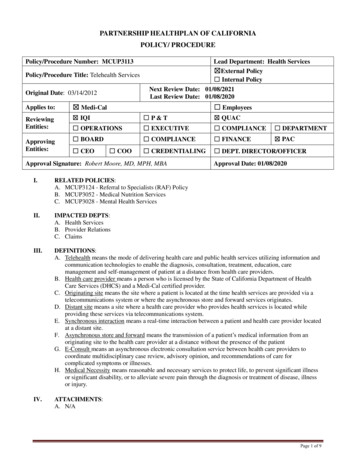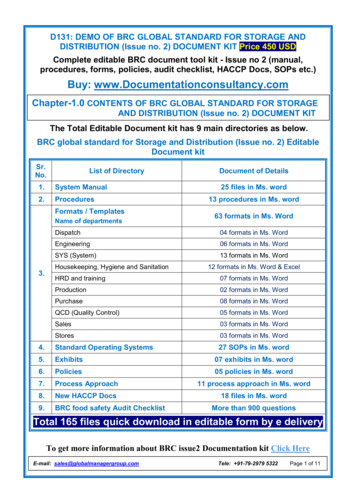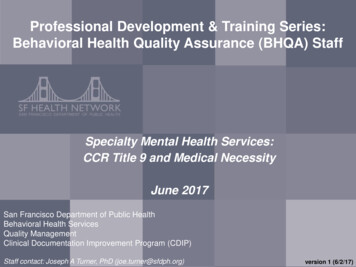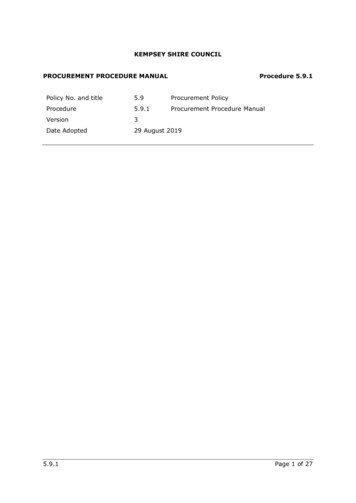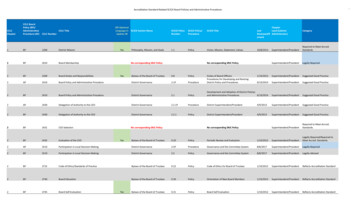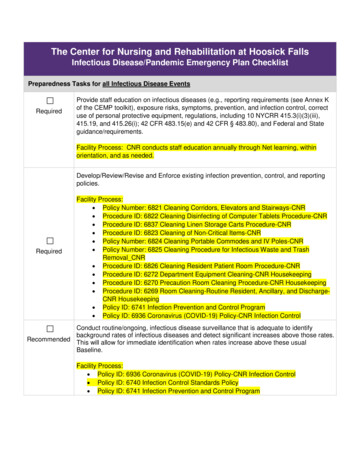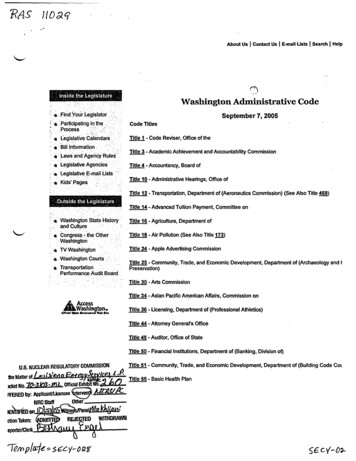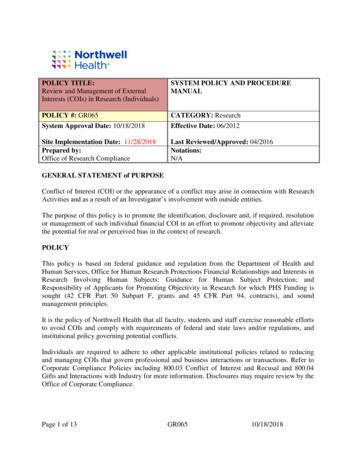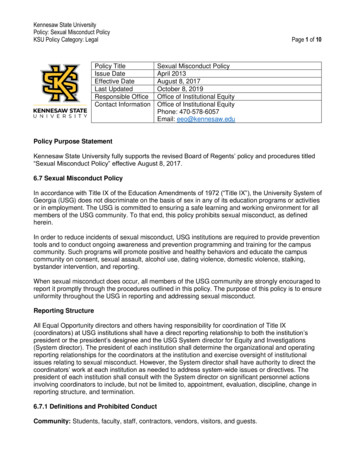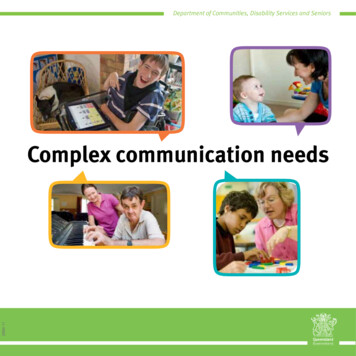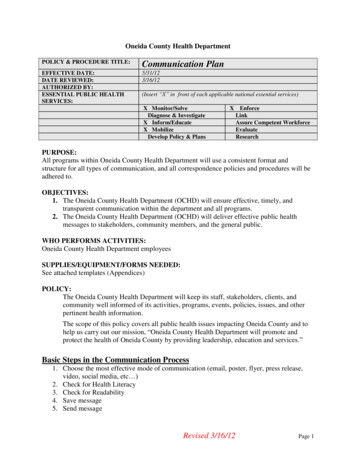
Transcription
Oneida County Health DepartmentPOLICY & PROCEDURE TITLE:Communication PlanEFFECTIVE DATE:DATE REVIEWED:AUTHORIZED BY:ESSENTIAL PUBLIC HEALTHSERVICES:5/31/123/16/12(Insert “X” in front of each applicable national essential services)X Monitor/SolveDiagnose & InvestigateX Inform/EducateX MobilizeDevelop Policy & PlansXEnforceLinkAssure Competent WorkforceEvaluateResearchPURPOSE:All programs within Oneida County Health Department will use a consistent format andstructure for all types of communication, and all correspondence policies and procedures will beadhered to.OBJECTIVES:1. The Oneida County Health Department (OCHD) will ensure effective, timely, andtransparent communication within the department and all programs.2. The Oneida County Health Department (OCHD) will deliver effective public healthmessages to stakeholders, community members, and the general public.WHO PERFORMS ACTIVITIES:Oneida County Health Department employeesSUPPLIES/EQUIPMENT/FORMS NEEDED:See attached templates (Appendices)POLICY:The Oneida County Health Department will keep its staff, stakeholders, clients, andcommunity well informed of its activities, programs, events, policies, issues, and otherpertinent health information.The scope of this policy covers all public health issues impacting Oneida County and tohelp us carry out our mission, “Oneida County Health Department will promote andprotect the health of Oneida County by providing leadership, education and services.”Basic Steps in the Communication Process1. Choose the most effective mode of communication (email, poster, flyer, press release,video, social media, etc )2. Check for Health Literacy3. Check for Readability4. Save message5. Send messageRevised 3/16/12Page 1
I. INTERNAL COMMUNICATIONInternal Communication Processes1. For routing of time sensitive/critical requests to appropriate OCHD staff, the Directoror Assistant Director will utilize the most efficient and accurate form ofcommunication deemed appropriate.2. Modes of Internal Communicationa. OCHD All-Staff Meetings: The frequency of all-staff meetings is monthly.Notice of meetings and agendas are sent to staff via email in advance of meetingdate. Minutes are archived and can be viewed by going to G:\NSSHARE\STAffMeetings\All STaffb. Program specific staff meetings: The frequency of program specific staffmeetings is monthly. Notice of meetings and agendas are sent to appropriate staffvia email in advance of meeting date. Minutes are archived and can be viewed bygoing to G:/NSSHARE/STAFF Meetings/ (specific program)c. Departmental e-mailsd. Verbal communicatione. Department-wide distribution of press releases and other information distributedpublicallyf. Desired communication with hard copy department routing form identifying staffto be receiving communicationg. Telephoneh. OtherNOTE: Staff Notification of New or Updated Policies/Procedures:At times, OCHD staff need to be made aware of new policies/procedures or updates that may have animpact on them. Based on the importance of these updates, Administration may communicate thisinformation via phone message, all-staff email, staff meeting, or posting within the department. Whenroutine forms of communication come out, there will then be an update/reminder about the priornotification and a more in-depth explanation.Assumptions All staff will be trained on this policy Informal internal communication (routine emails, verbal conversations, phone calls, etc.do not fall under this policy). The communication must have relevance to OCHD staff to fall under this policy Emergency requests/situations may have exceptions Confidential patient information shared between OCHD employees requires special careto avoid incidental disclosure. Please see confidentially policy.o The Privacy Rule recognizes that overheard communications in treatment settingmay be unavoidable and allows for incidental disclosures. The Privacy Rule permitscertain incidental disclosures of protected health information to occur when thecovered entity has in place reasonable safeguards and minimum necessary policiesand procedures to protect individuals’ privacy.Revised 3/16/12Page 2
OCHD Teams:There are two main teams within the OCHD that are built around the Agency Strategic Plan.These teams are:1. Quality Improvement/Accreditation Team (QIAT)2. Leadership Team (LT)These teams meet regularly and are responsible for guiding the OCHD towards the mission,vision, and goals of the department as identified in the Strategic Plan and are responsible forassuring the performance management plan is functional, appropriate, and current. The teamagendas and minutes are key pieces of information for internal staff who may not get thisinformation first-hand by being on the teams. These documents can be found in NSSHARE:1. QIAT: G:\NSSHARE\Quality Improvement2. LT: G:\NSSHARE\Leadership TeamRelevant information from these two teams will be added to the All Staff Meeting agenda anddiscussed with the all Oneida County Health Department employees during All Staff meetings.II. EXTERNAL COMMUNICATIONProtocol for messagingChoosing a mode of communication: Decide how the message will go out.1. Make sure the message is compliant with HIPPA Regulations. See Appendix 8.2. Use appropriate OCHD template. See appendices 1-7.3. Check the message for Health Literacy: A well-crafted message will avoidcomplicated language and technical or medical terms when possible. Appendix 9shows some basic Health Literacy guidelines.4. Check for Readability: Always check your messages for readability. Thereadability level should be between a 5th and 9th grade reading level. Appendix 10shows you how to perform a readability check on your message.5. Save your message: Save message to the desired folder. Be sure to save yourmessage so that it is easily identified.6. Route your message for feedback: Send your message to Health Officer/Director,Assistant Director, or other Health Department staff for feedback.Send your message: Once reviewed, you are responsible for distributing theinformation to all OCHD staff so they can be educated on the issue. Assignedsupport staff are responsible for distribution to media and posting to OCHDwebsite.Program logo placementOn all templates, the position of the health department logo shall not be altered. Programlogos can also be added to templates; however the health department logo should not bereplaced with program templates.Revised 3/16/12Page 3
External Communication Methodsa. Emaili. All OCHD employee e-mails should contain the confidentialitydeclaration. See Appendix 1.ii. Emails should be checked for spelling and grammariii. Confidential client information should not be sent via e-mail.b. Press Releasesi. All press releases should be written on Media press release template withOCHD letterhead. See Appendix 2 and Appendix 7.ii. Press releases should include the date as well as a contact name and phonenumber.iii. Press releases, like all written news information, should be checked forspelling and grammatical errors.iv. Press releases should be submitted to the appropriate support staff personfor distribution to respective news media and website.v. Published press releases should be cut out of the newspaper and kept forrecord.c. Health Alert to Providersi. All Health alerts should be written on OCHD Health Alert template withOCHD letterhead. See Appendix 6.ii. Health alerts should include the date of alert, date of alert period, reasonfor alert, instructions to targeted audience, contact name and phonenumber.iii. Health alerts, like all written information, should be checked for spellingand grammatical errors.iv. Health Alerts are to be approved by Director/Assistant Director.v. Health Alerts will be emailed to Assistant Director for distribution toOneida County Syndromic Surveillance group.d. Interviewsi. Decisions regarding the authorization of an interview are made by theDirector, Assistant Director, or respective staff person. Authorizationcriteria include:1. Appropriateness of the interview, topic and venue2. Availability of the selected key OCHD staff in light of primaryresponsibilities3. Potential for exacerbating versus calming public fear or anxiety4. Potential for relating information that cannot or should not bedisclosed5. The impact the information conveyed could have on otherorganizations6. The assessed intent of reporter or other media representativeRevised 3/16/12Page 4
ii. Message Maps should be utilized by staff to assist in developing messagefor media. See Appendix 3.e. News Conferencei. Should a confirmed crisis or emergency occur, the public informationofficer or designee will get factual and appropriate information to thepublic as quickly as possible. Getting this information out will likelyinclude the need to conduct a news conference, providing reporters withthe facts of the events as known and not known, providing information onsteps being taken in response to the event, and providing opportunities forreporters to ask questions.1. Basic Elements of a news conference agenda generally include:a. What happened- opening remarks to provide confirmed andappropriate facts of the event.b. What is being done by OCHD- steps OCHD personnel aretaking, as appropriate to discussc. What’s be done for affected individuals or groupsd. Questions and answers- the person opening the newsconference should moderate, should direct any undirectedquestions to the appropriate person, and should close with arepetition of key messages.2. Possible Handoutsa. Agenda with names and title of participantsb. Situation fact sheetc. Issue fact sheetf. Social MediaNOTE: Social media is fast becoming one of the most preferred methods of individuals forcommunicating and sharing information. The OCHD recognizes this and wishes to providesocial media outlets that allow the public to be able to get the latest information andguidance from OCHD. However, with the luxury of up-to-the-minute information andconvenience comes the responsibility of OCHD to ensure that its Information Systems areprotected and that employees use the social media sites for their intended purpose. All county or health department sponsored and supported social network sitesmust be approved by the department head. The content of all social network sites is to be compliant with State and Federallaws and consistent with the business objectives and existing policies of theOCHD and Oneida County. Each program will be responsible for establishing employee posting access,monitoring content and general maintenance of social network sites. County and/or health department management reserves the right to suspend ordiscontinue any site where content and/or site maintenance does not meet predetermined standards. Social media sites may not be used as a means of exchanging information withor between County Board or Committee members where such exchange couldbe considered a ‘meeting’ and a violation of Wisconsin Open Records Laws. Opinion statements are not to be posted using any work-related social networksites. It is in direct violation of this policy to “friend” clients on your personal socialmedia sites.Revised 3/16/12Page 5
i.No personal or health related information will be communicated with clients viaany social network site.Website1. The Oneida County health Department maintains a public accesswebsite. News updates, both informational and emergency, will beposted to the home page. Information will be posted in a timelyfashion as it becomes available.2. At least one designated employee shall be responsible for regularmaintenance and review of the website.ii. Facebook1. The Oneida County Health Department will utilize the socialnetworking site Facebook to distribute public health information(emergency and non-emergency).2. At least one designated employee shall be responsible for regularmaintenance and review of the Facebook page.3. Employees utilizing Facebook should be sure to only visit relevantpages (personal pages are prohibited).g. Telephonei. Telephone Lines1. The Oneida County Health Department uses a public accesstelephone line (715-369-6111) and employee access telephonelines during normal working hours.2. After business hours the telephone number is forwarded to ananswering machine with messages that refer the caller to thedispatch center for public health emergencies on a 24/7 basis. Thehealth director will be contacted upon report of the emergency.3. Employee access voicemails should be checked on a regular basisand phone calls returned within the appropriate time frame.4. Confidential patient information can be shared via telephone;however care should be taken to avoid incidental disclosure.a. The Privacy Rule recognizes that overheardcommunications in treatment setting may be unavoidableand allows for incidental disclosures. The Privacy Rulepermits certain incidental disclosures of protected healthinformation to occur when the covered entity has in placereasonable safeguards and minimum necessary policies andprocedures to protect individuals’ privacy.h. Lettersi. Use Oneida County Health Department letterhead. See Appendix 5.ii. See protocol for messaging.i. Faxi. Oneida County Health Department maintains two fax lines1. The primary fax number used by Oneida County HealthDepartment is 715-369-6112.Revised 3/16/12Page 6
2. The fax number used by the reproductive health program is 715369-2553.ii. Fax cover sheets should be used when sending faxes to any recipient. SeeAppendix 4.iii. Confidential patient information can be sent via fax with the appropriatemeasures taken.1. Should include “Confidential” written on fax cover sheet2. Sender should assure that the fax machine is only used by intendedrecipient (agency or individual).REFERENCES: See attached appendices for additional details and information.Revised 3/16/12Page 7
Appendix 1: Sample Email Template***Important: This e-mail message is intended for the exclusive use of the recipient(s) namedabove. It may contain information that is protected, privileged, or confidential, and it should notbe disseminated, distributed, or copied to persons not authorized to receive such information. Ifyou are not the intended recipient, any dissemination, distribution, or copying is strictlyprohibited. If you think you have received this e-mail message in error, please notify the senderimmediately.***Revised 3/16/12Page 8
Appendix 2: Sample News Press Release TemplateLocation: G:\NSSHARE\Forms and Sample Letters\FORMS***Press releases should be developed at a Flesch-Kinkaid Reading Level of 5th to 9th grade. Tocheck the reading level of developed press releases in Microsoft Word, Click on Review (Word2007) or Tools (Word 2003), then click Spelling and Grammar, then click Options, then makesure “Show Readability Statistics” is checked. Run Spelling and Grammar check on document.When finished a Readability Statistics box will appear with data.***Revised 3/16/12Page 9
Appendix 3: Message Map SampleLocation: G://NSSHARE/riskcommunicaiton/otherMessage e updated:Radon4/3/07General PublicQuestion or Concern:What is Radon?Key Message/Fact 1:Key Message/Fact 2:Key Message/Fact 3:Radon is a naturallyoccurring, ordorless,radioactive gas.It causes cancerDetecting and mitigatingSupporting Fact 1-1:Supporting Fact 2-1:Supporting Fact 3-1:Radon comes from traceamounts of Uranium in theground.When you breathe radon, itgoes in your lungs andincreases your risk of lungcancer.5-10% of homes inWisconsin have elevatedlevels of radon.Supporting Fact 1-2:Supporting Fact 2-2:Supporting Fact 3-2:The gas can dissolve intowater and go into the air bytaking a shower, laundryingor washing dishes.When a house is sealed inwinter, it increases theamount of radon gasexposure.Many hardware stores havetest kits for 20 to 30.Supporting Fact 1-3Supporting Fact 2-3Supporting Fact 3-3There aren’t any symptoms, soit is important to test yourhome for radon.Professionals can be hired tokeep the radon from gettinginto your home.Radon gas can seep intohomes through thefoundationRevised 3/16/12Page 10
Appendix 4: Sample Fax TemplateLocation: G:\NSSHARE\Forms and Sample LettersRevised 3/16/12Page 11
Appendix 5: Sample Letterhead TemplateLocation: G:\NSSHARE\Forms and Sample LettersRevised 3/16/12Page 12
Appendix 6: Health Alert to Syndromic Surveillance GroupLocation: G:\NSSHARE\Forms and Sample LettersRevised 3/16/12Page 13
Appendix 7: Public Health Alert (Sample)Location: G:\NSSHARE\BOIL WATER NOTICEOneida County Health DepartmentCourthouse1 S. Oneida, P. O. Box 400Rhinelander, WI 54501Telephone (715)369-6111Fax (715) 369-6112Caring handsof public health.Linda Conlon, BAN, RNDirectorAnn Ovsak, BSN, RNAssistant DirectorFOR IMMEDIATE RELEASEDate: 10/4/11Contact: Linda Conlon BAN, RN, MPH715-369-6111or Ron Groth715-356-4454LAKELAND SANITARY DISTRICT BOIL WATER NOTICE CONTINUESLakeland Sanitary District continues to be under a boil water advisory due to total coliform bacteria found in recentroutine testing. Retesting the municipal water supply has yielded one negative result and we are waiting for resultsof the second re-sampling. Tests should be available tomorrow. The Lakeland Sanitary District, with guidancefrom the Department of Natural Resources, worked diligently at correcting the situation by chlorinating and flushingthe system. An update to the water situation is expected by Wednesday October 5, 2011. As a reminder to peoplewho reside in Lakeland who are served by the municipal water:Coliform bacteria may be found when drinking water is tested. This type of bacteria lives naturally insoil and in the waste of warm-blooded animals. They can also grow as a film in water pipes. Mostcoliform are not harmful, but do indicate the possible presence of other disease-causing microbes(viruses, harmful bacteria and parasites) that are often found in soil and feces.Health effects associated with coliform bacteria in waterAlthough coliform bacteria are not usually harmful, illness may be caused by other microbes in thewater. Typical symptoms may include diarrhea, cramps, nausea or jaundice with headaches orfatigue. Please note that these symptoms may be caused by factors other than unsafe water. If youbecome ill with the above symptoms during a boil water notice, you should talk to your doctor.Revised 3/16/12Page 14
SAFE water must be used until you get the “ALL CLEAR”Examples of safe water include: Commercially bottled water.Packaged ice from an approved source is safe.Water that has been at a rolling boil for 1 minute (CDC- Centers for Disease Control). A public water system that is in compliance. Please note that the container that is being used to transportthe water must be cleaned or sanitized before filling it with water in order to keep the water safe to drink.Water from a private well that has tested safe by a homeowner. Use only SAFE water for the following purposes: Drinking, cooking, making baby formula, coffee, juices, other beverages or ice.Watering pets Washing ready to eat fruits and vegetables Bathing infants, washing open wounds, or brushing teeth Rinsing dishes (or you may add 1 Tablespoon of bleach to 2 gallons of tap water) DO NOT use ice cubes from your freezer or any beverages that that were made with unsafe water.While under the advisory, you may use your current water for the following: Bathing (except infants), showering, washing hands and washing dishesWashing dishes in automatic dishwashers that uses a heating element to dry dishesWashing cars and watering lawnsPlease Note: Elderly people, small children (including infants), and individuals who have poorimmune systems due to illness should be very careful to follow all health and safety warnings duringa boil water/bottled water notice. If you or anyone you care for has a poor immune system, consultwith your doctor for additional advice.For more information about safe drinking water, contact the Oneida County Health Department at 369-6205 orcheck our website for updated information at www.oneidacountypublichealth.org.Revised 3/16/12Page 15
Appendix 8: HIPAA RequirementsPrivacy RuleThe effective compliance date of the Privacy Rule was April 14, 2003 with a one-year extension forcertain "small plans". The HIPAA Privacy Rule regulates the use and disclosure of certain informationheld by "covered entities" (generally, health care clearinghouses, employer sponsored health plans, healthinsurers, and medical service providers that engage in certain transactions.)[11] It establishes regulationsfor the use and disclosure of Protected Health Information (PHI). PHI is any information held by acovered entity which concerns health status, provision of health care, or payment for health care that canbe linked to an individual.[12] This is interpreted rather broadly and includes any part of an individual'smedical record or payment history.Covered entities must disclose PHI to the individual within 30 days upon request.[13] They also mustdisclose PHI when required to do so by law, such as reporting suspected child abuse to state child welfareagencies.[14]A covered entity may disclose PHI to facilitate treatment, payment, or health care operations,[15] or if thecovered entity has obtained authorization from the individual.[16] However, when a covered entitydiscloses any PHI, it must make a reasonable effort to disclose only the minimum necessary informationrequired to achieve its purpose.[17]The Privacy Rule gives individuals the right to request that a covered entity correct any inaccurate PHI.[18]It also requires covered entities to take reasonable steps to ensure the confidentiality of communicationswith individuals.[19] For example, an individual can ask to be called at his or her work number, instead ofhome or cell phone number.The Privacy Rule requires covered entities to notify individuals of uses of their PHI. Covered entitiesmust also keep track of disclosures of PHI and document privacy policies and procedures.[20] They mustappoint a Privacy Official and a contact person[21] responsible for receiving complaints and train allmembers of their workforce in procedures regarding PHI.[22]An individual who believes that the Privacy Rule is not being upheld can file a complaint with theDepartment of Health and Human Services Office for Civil Rights (OCR).[23][24] However, according tothe Wall Street Journal, the OCR has a long backlog and ignores most complaints. "Complaints ofprivacy violations have been piling up at the Department of Health and Human Services. Between Aprilof 2003 and November of 2006, the agency fielded 23,886 complaints related to medical-privacy rules,but it has not yet taken any enforcement actions against hospitals, doctors, insurers or anyone else for ruleviolations. A spokesman for the agency says it has closed three-quarters of the complaints, typicallybecause it found no violation or after it provided informal guidance to the parties involved."[25] However,in July 2011, UCLA agreed to pay 865,500 in a settlement regarding potential HIPAA violations. AnHHS Office for Civil Rights investigation showed from 2005 to 2008 unauthorized employees, repeatedlyand without legitimate cause, looked at the electronic protected health information of numerous UCLAHSpatients.[26]For more information on HIPAA, please visit;http://en.wikipedia.org/wiki/Health Insurance Portability and Accountability ActRevised 3/16/12Page 16
Appendix 9: Health Literacy GuidanceWhen teaching patients with low health literacy, remember: Literacy and intelligence are not necessarily correlated. Patients with low literacy skillsmay be highly intelligent, and simply need to be taught in ways supported by theirstrengths.Our culture values literacy, so people often do not want to admit to low or no literacyskills, and may go to some lengths to keep this information hidden. It is very importantthat the healthcare professional remain non-confrontational, non-judgmental andsupportive when making any assessment of the patient’s literacy abilities.Make no assumptions about literacy level based on the patient’s appearance, race, age,financial status, religion, culture or place of origin. Assess carefully.Reading level assessment of text (and there are many indices) is based largely on thesecharacteristics:– Average number of words per sentence– Average number of syllables per word– Difficulty of vocabularyMost commercially available patient education materials (including many on the internet)are written at a 9th -10th grade level or higher. Many patients may not be able to read andcomprehend these materials.It is far too easy for healthcare professionals to underestimate the impact of low healthliteracy. Literacy has been defined as “more than just the ability to read”.It encompasses comprehension, problem-solving skills, synthesis and analysis ofinformation, abstract thinking and reasoning, the capacity to recognize patterns and theability to generalize from them, and the development of a broad general knowledgebase”. Patients with low literacy skills may not be willing to express lack ofunderstanding; may not have the vocabulary to ask pertinent questions; and may not useexplicit adjectives in describing symptoms and development of their health concerns.Unexpected problems can arise, based on assumptions the healthcare professional maymake about the patient’s basic knowledge concerning anatomy, physiology, basic healthand hygiene, and skills such as telling time, calculating simple measures, using atelephone or pager, understanding numbers, etc.Assessment of literacy skills should be low-key and gentle:Look – Does the patient read? What is being read?Listen – Does the patient ask questions indicating material has been read understood?Get to know the patient – Ask what the patient enjoys doing for relaxation?Is reading mentioned?– Does the patient regularly need help with items that need to be read, such asmenus, brochures, labels, directions, etc.?When teaching patients with low literacy skills:– Teach in small increments of time (a few minutes to no more than 30 minutes).– Present one idea or topic at a time.– Teach essential information first.Revised 3/16/12Page 17
– Teach at a time when the patient is interested - the ‘golden moment’.– Repeat key information.– Be consistent in the terms used (use ‘operation’ or ‘surgery’, not both).– Use short, simple words, avoiding medical jargon and slang terms.– Use short, simple sentences.– Use easily understood analogies.– Evaluate learning often (have the patient restate and/or demonstrate).When choosing or writing materials for patients with low literacy skills, the followingcharacteristics (very succinctly) facilitate reading and comprehension:– Large print.– Simple serif font.– Clear headings and sub-headings.– Lots of white space.– Pertinent, simple line-drawings (these serve as landmarks and s visitors/health information/pdf/gdl%20teaching%20ll.pdfRevised 3/16/12Page 18
Appendix 10: How to Conduct a Readability CheckYou can use the MS Word spell check to test readability of a highlighted section or anentire document.This test checks whole sentences that end in a period, question mark, or exclamationpoint. Fragments and headings are not checked.The Flesch Reading Ease statistic is a readability score that can be interpreted by usingthe chart on the right. A score of 60 and above rates as Plain Language.To have the Spell Check display the Readability Statistics, go to Tools Options Spelling & Grammar and make sure that Check Grammar with Spelling is checked as well asShow Readability Statistics.In versions of Word before 2003, the Flesch-Kincaid Grade Level measure did notregister above 12th grade level. To use Flesch-Kincaid, work towards a score of between a 5thand 9th grade reading level.Revised 3/16/12Page 19
POLICY & PROCEDURE TITLE: Communication Plan EFFECTIVE DATE: 5/31/12 DATE REVIEWED: 3/16/12 AUTHORIZED BY: ESSENTIAL PUBLIC HEALTH SERVICES: (Insert "X" in front of each applicable national essential services) X Monitor/Solve X Enforce Diagnose & Investigate Link X Inform/Educate Assure Competent Workforce
